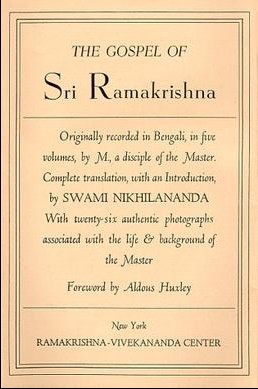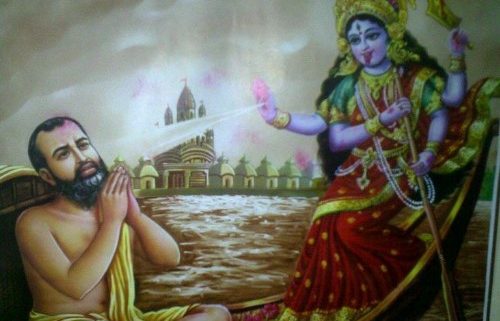The Gospel of Sri Ramakrishna – Book Review
The holy book The Gospel of Sri Ramakrishna, was originally Written in Bengali by “Ma-” (Mahendranath Gupta) and translated to English by Swami Nikhilananda.
The Gospel is a virtual source book for all facets of Hinduism, a treasure trove of spiritual knowledge, accessible to all, expounded in the most simple language comprehensible to one and all. It is no wonder this voluminous collection of extensive teachings of Ramakrishna Paramahamsa, recorded more than a century and a quarter ago, is still being read spellbound by earnest spiritual speakers across the globe, cutting across all religious barriers.
Who is Sri Ramakrishna?
Sri Ramakrishna Paramahamsa (1836-1886) was one of the greatest spiritual masters of Hinduism, who lived at Dakshineswar (near Kolkotta, India). Considered to be Divine Avatar (God’s incarnation in human form), Sri Ramakrishna, who hardly had a rudimentary primary education turned out to be a spiritual volcano, who through his all consuming devotion on divine mother Kali, had a vision of her. He spent 12 years in intense spiritual practices in various paths of Hinduism and attained God realization/ self realization/ Nirvikalpa Samadhi/ Atma sakshatkar.

He is a rare spiritual personality, who personally engaged himself in practicing the various paths of attainment of the Supreme divine bliss that Hinduism presents as suited to people of different tastes, capacities of intake and mindset. He practiced the path of Bhakthi (devotion), Gnyana (the path of Self Inquiry) and Tantra(Kundalini Yoga) at varying times by undergoing intense practice and attained the ultimate divine experience in each path. Despite being a realized person himself, he opted to be under the guidance of specific Gurus who were masters in their specific paths to guide him procedurally in those paths.
He also practiced the disciplines of Islam and Christianity for a while and attained divine experience through these religions too. By the strength of his experience, he confirmed that the ultimate truth and experience of God attained by following various paths is one and the same. This virtually unlettered person turned out to be a great exponent in explaining the intricacies of Hinduism in all its facets and tenets, which even learned pundits cannot fathom.
He declared that every Religion, every sub-sect and every method of practice is ultimately intended to take man to this highest goal in life. And he declared “As many faiths, so many paths” purely by the strength of his own experiences.
His prime disciple, Swami Vivekananda later founded Sri Ramakrishna Math and Mission and spread spirituality and selfless service, with the able assistance from his master’s other Sanyasi (relinquished) disciples.
Who is Ma- , Mahendranath Gupta?

Sri Ma- Mahendranath Gupta fondly called Master Mahasaya. He is an apostle and evangelist of Sri Ramakrishna Paramahamsa
A school teacher by profession, Mahendra Nath Gupta was a house-holder disciple of Sri Ramakrishna who was destined to end up at the Feet of his Master in a time of utter mental turmoil. He was associated with Sri Ramakrishna for a period of about 5 years till his master’s death, and he was divine-commissioned to be the authentic recorder of Sri Ramakrishna’s profound teachings.
Ma-, after every meeting with his Master, recorded his conversations in his diary with details of date, people present, topics and summary of the discussions that took place and a brief descriptions of the place and scenario. After his masters passing away, Ma- wrote those diary notes into elaborate publications, spanning over 5 volumes in his mother tongue Bengali. The Bengali gospel was titled “Sri Sri Ramakrishna Kathamrut” At first it was published in 1897 as a small booklet. It received lots of attention and appreciation from the Master’s devotees. Later, it became his life mission. He was engaged in this massive task till the end of his life. “Sri Sri Ramakrishna Kathamrith” was published by him in 5 volumes one after the other in 1902,1904, 1098,1910 and 1932. The last volume got published only shortly after Ma’s death in 1932, but before that Ma- had finished complete proof reading of the book and he was ready to depart, having fulfilled his life’s mission.

Sri Sri Ramakrishna Kathamrit 5 parts.
The greatness of the Gospel of Sri Ramakrishna
Perhaps in the history of religious teachers, it is the first time that the spiritual teachings of a great master have been recorded with such a precision and truthfulness. The conversations will bring before the reader’s mind an intimate picture of the Master’s eventful life from March 1882 to April 24, 1886. With vivid description of the scenario, the moods and the nature of the people present, the song and the dance made, the utterances of the master in his native simplicity and rustic beauty have been brought out by Ma- in a wonderful way in the book.
Sri Ramakrishna could expound the deep religious truths of Hinduism that eluded comprehension to the greatest scholars in the simplistic way, with down to earth examples. As one reads the Gospel, one could see that Dvaita (Duality), advaita (Non-duality), Visishtadvaita (Qualified non-duality), Bhakti Yoga (Path of devotion), Karma Yoga (path of selfless work), Gnyana yoga (path of self-inquiry), Hatha Yoga, Raja Yoga, Tantric practice, the concept of Avatar, God with Form, God without form, Kundalini yoga, the various Samadhis all the facets of Hinduism have been wonderfully explained by Sri Ramakrishna. It could be treated as one source book of Hinduism which can be read and understood by any earnest follower of Hinduism with out need for an any intellectual interpretation.
The book starts with Ma-‘s first visit to Dakshineshwar to meet the master. He gets captivated by Sri Ramakrishna’s simplicity, loving words and the divinity that he radiates. He soon makes a second visit; the master starts asking more personal details about Ma-. He finds Ma- to be possessing physical features indicative of spiritual substance in him. Ma- starts asking questions and he gets answers that hit him point blank with utter straightforwardness and simplicity that could shatter his ego. He becomes like a ‘peacock fed with a little opium’. Lured by the addictive power of the opium, the peacock starts coming again and again to Sri Ramakrishna to partake the feed!
The greatness of the Gospel not only lies in the substance of the master’s profound teachings but also on the wonderful narrative skills of Ma-. When you read the Gospel, you would feel like getting transported back to those times, to be at the places where Sri Ramakrishna lived, sang, danced, froze in Samadhi, traveled, visited, ate and jovially chitchatted with his devotees unleashing his childlike guilelessness and spontaneous humor. You would meet his closest devotees who became great spiritual monks and other prominent devotees of Ramakrishna in future. You would feel like being present along with them, sitting in front of the master, partaking his prasad, singing with him, laughing with him and dancing with him in divine ecstasy.
When you read and re-read the Gospel, you will understand Bhagavad Gita better. Your doubts in Upanishad statements will get cleared. What you had judged as foolish idiosyncrasies of Hinduism earlier would become quite meaningful. The book has the potential to transform a common religious person to a spiritual aspirant. If you are a non-Hindu, you would get wonder-struck at the greatness of Sanatana Dharma. If you are a Christian, you will start understanding the Bible better; your reverence on Jesus Christ will increase. If you are a Muslim and studied the Gospel in all earnestness, you will finally understand why it is so important to segregate ‘the sugar from the sand’ in religious scriptures.

Swami Nikhilananda
The English Version
Swami Nikhilananda, a monk of the Ramakrishna Order, for the benefit of English speaking readers took up the monumental work of translation of the Gospel into English and completed it in the year 1942 and was first published by Ramakrishna-Vivekananda Centre, New York.
About his effort, Swami Nikhilananda says:
“I have made a literal translation, omitting only a few pages of no particular interest to English-speaking readers. Often literary grace has been sacrificed for the sake of literal translation. No translation can do full justice to the original. This difficulty is all the more felt in the present work, whose contents are of a deep mystical nature and describe the inner experiences of a great seer. Human language is an altogether inadequate vehicle to express supersensuous perception.”

The Gospel of Sri Ramakrishna – First edition Year: 1942
He wants the readers of the Gospel (particularly from West, who are not too familiar with Hinduism) to keep in mind the following: “But these words were not the product of intellectual cogitation; they were rooted in direct experience. Hence, to students of religion, psychology, and physical science, these experiences of the Master are of immense value for the understanding of religious phenomena in general. No doubt Sri Ramakrishna was a Hindu of the Hindus; yet his experiences transcended the limits of the dogmas and creeds of Hinduism. Mystics of religions other than Hinduism will find in Sri Ramakrishna’s experiences a corroboration of the experiences of their own prophets and seers. And this is very important today for the resuscitation of religious values. The skeptical reader may pass by the supernatural experiences; he will yet find in the book enough material to provoke his serious thought and solve many of his spiritual problems.”
The Gospel is also available (translated from original Bengali version) in all major languages of India. One of the earliest translation of the book was done in Tamil and the book is titled “Sri Ramakrishnarin Amutha mozhigaL” (ஸ்ரீ ராமகிருஷ்ணரின் அமுதமொழிகள்) in 3 volumes, available from Sri Ramakrishna Math,Chennai.

If you want to buy The Gospel of Sri Ramakrishna online, here is the link: https://istore.chennaimath.org/product/the-gospel-of-sri-ramakrishna-royal-edition/
![]()







 This website has been conceived and being developed by C.V.Rajan. He is a retired Engineer and an ex-design consultant, now living with his wife in Ashram at Amritapuri, Kerala, spending his retired life in quest of spirituality under the holy feet of Amma, Satguru Mata Amritanandamayi.
This website has been conceived and being developed by C.V.Rajan. He is a retired Engineer and an ex-design consultant, now living with his wife in Ashram at Amritapuri, Kerala, spending his retired life in quest of spirituality under the holy feet of Amma, Satguru Mata Amritanandamayi.
Leave a Reply
Want to join the discussion?Feel free to contribute!